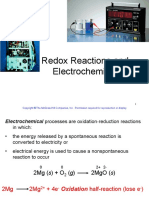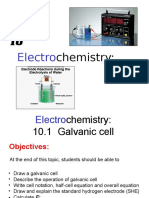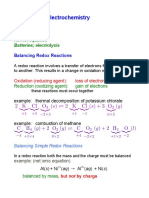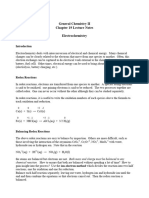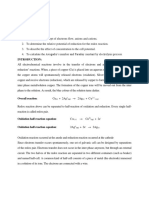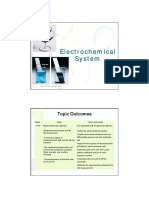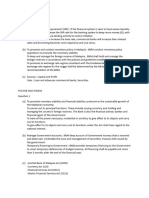Chapter 2: Electrochemistry
Outline
1.
2.
3.
4.
5.
6.
Redox Reaction: Reduction, Oxidation & Oxidation
Number
Redox Reaction: Balancing Redox using Half- Reaction
Method
Electrolysis & Electrolytic Cells
Voltaic Cells & Cells Potentials
Nernst Equation
Primary & Secondary cells.
�What is Redox Reaction
�Electrochemical processes are oxidation-reduction reactions in which:
the energy released by a spontaneous reaction is converted to electricity or
electrical energy is used to cause a nonspontaneous reaction to occur
2+ 2-
2Mg (s) + O2 (g)
2Mg
O2 + 4e4
2MgO (s)
2Mg2+ + 4e-
Oxidation half-reaction (lose e-)
2O2-
Reduction half-reaction (gain e-)
�Oxidation number
The charge the atom would have in a molecule (or an
ionic compound) if electrons were completely transferred.
1.
Free elements (uncombined state) have an oxidation number of zero.
Na, Be, K, Pb, H2, O2, P4 = 0
2.
In monatomic ions, the oxidation number is equal to the charge on the ion.
Li+, Li = +1; Fe3+, Fe = +3; O2-, O = -2
3.
5
The oxidation number of oxygen is usually 2. In H2O2 and O22- it is 1.
�4.
The oxidation number of hydrogen is +1 except when it is bonded to metals in binary
compounds. In these cases, its oxidation number is 1.
5.
Group IA metals are +1, IIA metals are +2 and fluorine is always 1.
6. The sum of the oxidation numbers of all the atoms in a molecule or ion is equal to the
charge on the molecule or ion.
HCO3
Identify the oxidation numbers of all the atoms in
HCO3 ?
O = 2
H = +1
3x(2) + 1 + ? = 1
6
C = +4
�Balancing Redox Equations
The oxidation of Fe2+ to Fe3+ by Cr2O72- in acid solution?
1.
Write the unbalanced equation for the reaction ion ionic form.
Fe2+ + Cr2O72-
2.
Fe3+ + Cr3+
Separate the equation into two half-reactions.
+2
Fe2+
Oxidation:
+6
Reduction:
3.
Cr2O7
Cr3+
Balance the atoms other than O and H in each half-reaction.
Cr2O727
2-
Fe3+
2Cr3+
+3
+3
�Balancing Redox Equations
4.
For reactions in acid, add H2O to balance O atoms and H+ to balance H atoms.
Cr2O72-
2Cr3+ + 7H2O
14H+ + Cr2O725.
Add electrons to one side of each half-reaction to balance the charges on the half-reaction.
Fe2+
Fe3+ + 1e-
6e- + 14H+ + Cr2O72-
6.
2Cr3+ + 7H2O
If necessary, equalize the number of electrons in the two half-reactions by multiplying the halfreactions by appropriate coefficients.
6Fe2+
8
2Cr3+ + 7H2O
6Fe3+ + 6e-
6e- + 14H+ + Cr2O72-
2Cr3+ + 7H2O
�Balancing Redox Equations
7.
Add the two half-reactions together and balance the final equation by inspection. The number of
electrons on both sides must cancel.
6Fe2+
Oxidation:
6e- + 14H+ + Cr2O72-
Reduction:
14H+ + Cr2O72- + 6Fe2+
8.
6Fe3+ + 6e2Cr3+ + 7H2O
6Fe3+ + 2Cr3+ + 7H2O
Verify that the number of atoms and the charges are balanced.
14x1 2 + 6 x 2 = 24 = 6 x 3 + 2 x 3
9.
9
For reactions in basic solutions, add OH- to both sides of the equation for every H+ that appears in
the final equation.
�Galvanic Cells
anode
oxidation
cathode
reduction
spontaneous
redox reaction
10
�Galvanic Cells
The difference in electrical potential between the
anode and cathode is called:
cell voltage
electromotive force (emf)
cell potential
Zn (s) + Cu2+ (aq)
Cu (s) + Zn2+ (aq)
[Cu2+] = 1 M and [Zn2+] = 1 M
Cell Diagram
phase boundary
Zn (s) | Zn2+ (1 M) || Cu2+ (1 M) | Cu (s)
11
anode
salt bridge
cathode
�Standard Reduction Potentials
Zn (s) | Zn2+ (1 M) || H+ (1 M) | H2 (1 atm) | Pt (s)
Anode (oxidation):
Zn (s)
2e- + 2H+ (1 M)
Cathode (reduction):
Zn (s) + 2H+ (1 M)
12
Zn2+ (1 M) + 2e-
Zn2+ + H2 (1 atm)
H2 (1 atm)
�Standard Reduction Potentials
Standard reduction potential (E0) is the voltage associated with a reduction reaction at an
electrode when all solutes are 1 M and all gases are at 1 atm.
Reduction Reaction
2e- + 2H+ (1 M)
E0 = 0 V
13
Standard hydrogen electrode (SHE)
H2 (1 atm)
�Standard Reduction Potentials
E0 = 0.76 V
cell
Standard emf (E0 )
E0 = Ecathode 0- Eanode
cell
Zn (s) | Zn2+ (1 M) || H+ (1 M) | H2 (1 atm) | Pt (s)
E0 = EH /H -0E+Zn
cell
0.76 V = 0 - EZn
/Zn
/Zn
2
2+
2+
EZn0 /Zn
2+ = -0.76 V
2+ (1 M) + 2eZn
14
Zn
E0 = -0.76 V
cell
0
�Standard Reduction Potentials
E0 = 0.34 V
cell
E0 = Ecathode 0- Eanode
cell
Ecell0 = ECu
0.34 = ECu
ECu0
2+ =
/Cu
0 2+
EH /H
/Cu
0 -2+
0
/Cu
0.34 V
Pt (s) | H2 (1 atm) | H+ (1 M) || Cu2+ (1 M) | Cu (s)
Anode (oxidation):
Cathode (reduction):
15
H2 (1 atm) + Cu2+ (1 M)
H2 (1 atm)
2H+ (1 M) + 2e-
2e- + Cu2+ (1 M)
Cu (s) + 2H+ (1 M)
Cu (s)
0
0+
�16
E0 is for the reaction as written
The more positive E0 the greater the tendency
for the substance to be reduced
The half-cell reactions are reversible
The sign of E0 changes when the reaction is
reversed
Changing the stoichiometric coefficients of a
half-cell reaction does not change the value of
E0
�What is the standard emf of an electrochemical cell made of a Cd electrode in a 1.0 M Cd(NO3)2
solution and a Cr electrode in a 1.0 M Cr(NO3)3 solution?
Cd2+ (aq) + 2e-
Cd (s) E0 = -0.40 V
Cd is the stronger oxidizer
Cr3+ (aq) + 3e-
Cr (s) E0 = -0.74 V
Cd will oxidize Cr
Anode (oxidation):
2e- + Cd2+ (1 M)
Cathode (reduction):
2Cr (s) + 3Cd2+ (1 M)
3Cd (s) + 2Cr3+ (1 M)
E0 = Ecathode 0- Eanode
cell
E0 = -0.40 (-0.74)
cell
E0 = 0.34 V
17
cell
x2
Cr3+ (1 M) + 3e-
Cr (s)
Cd (s)
x3
�Spontaneity of Redox Reactions
DG = -nFEcell
DG0
n = number of moles of electrons in reaction
= -nFEcell 0
F = 96,500
DG0 = -RT ln K
E0cell =
RT
nF
V mol
= 96,500 C/mol
= -nFE0cell
ln K
(8.314 J/Kmol)(298 K)
E0cell =
0.0257 V
n
ln K
E0cell =
0.0592 V
n
log K
18
n (96,500 J/Vmol)
ln K
�Spontaneity of Redox Reactions
DG0 = -RT ln K
19
= -nFE0cell
�What is the equilibrium constant for the following reaction at 250C?
Fe (s) + 2Ag+ (aq)
E0cell =
0.0257 V
n
ln K
Oxidation:
E0 = EFe
2Ag+ + 2e-
2Ag
2e- + Fe2+
Reduction:
0 EAg
/Fe
2+ /Ag
n=2
Fe
E0 = -0.44 (0.80)
E0
E0 = -1.24 V
cell
xn
-1.24 V
0.0257 V
K= e
K = 1.23 x 10-42
20
Fe2+ (aq) + 2Ag (s)
0.0257 V
=e
x2
�The Effect of Concentration on Cell Emf
DG = DG0 + RT ln Q
DG = -nFE
DG0 = -nFE
-nFE = -nFE0 + RT ln Q
Nernst equation
E = E0 -
RT
ln Q
nF
At 298 K
E=
21
E0 -
0.0257 V
n
ln Q
E=
E0 -
0.0592 V
n
log Q
�Will the following reaction occur spontaneously at 250C if [Fe2+] = 0.60 M and [Cd2+] = 0.010
M?
Fe2+ (aq) + Cd (s)
Fe (s) + Cd2+ (aq)
Oxidation:
Cd
2e- + Fe2+
Reduction:
E0 = EFe
ECd /Cd
/Fe 2+
E0 = -0.44 (-0.40)
Cd2+ + 2e-
n=2
2Fe
2+
E=
E0 -
E0 = -0.04 V
E=
0.0257 V
n
0.0257 V
-0.04 V 2
E = 0.013
E>0
22
ln Q
Spontaneous
ln
0.010
0.60
�Concentration Cells
Galvanic cell from two half-cells composed of the same material but differing in ion concentrations.
23
�Batteries
Dry cell
Leclanch cell
Anode:
Cathode:
Zn (s)
+
2NH4 (aq) + 2MnO2 (s) + 2e-
Zn (s) + 2NH4 (aq) + 2MnO2 (s)
24
Zn2+ (aq) + 2eMn2O3 (s) + 2NH3 (aq) + H2O (l)
Zn2+ (aq) + 2NH3 (aq) + H2O (l) + Mn2O3 (s)
�Batteries
Mercury Battery
Anode:
Cathode:
Zn(Hg) + 2OH- (aq)
HgO (s) + H2O (l) + 2eZn(Hg) + HgO (s)
25
ZnO (s) + H2O (l) + 2e-
Hg (l) + 2OH- (aq)
ZnO (s) + Hg (l)
�Batteries
Lead storage
battery
Anode:
Cathode:
Pb (s) 4+ SO2- (aq)
PbO2 (s) + 4H+ (aq)4 + SO2- (aq) + 2e-
Pb (s) + PbO2 (s) + 4H+ (aq) + 2SO2- (aq) 4
26
PbSO4 (s) + 2ePbSO4 (s) + 2H2O (l)
2PbSO4 (s) + 2H2O (l)
�Batteries
27
Solid State Lithium Battery
�Batteries
A fuel cell is an electrochemical
cell that requires a continuous
supply of reactants to keep
functioning
Anode:
Cathode:
28
2H2 (g) + 4OH- (aq)
4H2O (l) + 4e-
O2 (g) + 2H2O (l) + 4e-
4OH- (aq)
2H2 (g) + O2 (g)
2H2O (l)
�Chemistry In Action: Bacteria Power
CH3COO- + 2O2 + H+
29
2CO2 + 2H2O
�Corrosion
Corrosion is the term usually applied to the deterioration of metals by an electrochemical process.
30
�Cathodic Protection of an Iron Storage Tank
31
�Electrolysis is the process in which electrical energy is used to cause a nonspontaneous chemical
reaction to occur.
Electrolysis of molten NaCl
32
�Electrolysis of Water
33
�Electrolysis and Mass Changes
charge (C) = current (A) x time (s)
1 mol e- = 96,500 C
34
�How much Ca will be produced in an electrolytic cell of molten CaCl2 if a current of 0.452 A is
passed through the cell for 1.5 hours?
2Cl- (l)
Anode:
Cathode:
Ca2+ (l) + 2eCa2+ (l) + 2Cl- (l)
Cl2 (g) + 2eCa (s)
Ca (s) + Cl2 (g)
2 mole e- = 1 mole Ca
mol Ca = 0.452
C
s
= 0.0126 mol Ca
= 0.50 g Ca
35
x 1.5 hr x 3600
s
hr
1 mol e96,500 C
1 mol Ca
2 mol e-
�Chemistry In Action: Dental Filling Discomfort
2+ Hg 0.85 V
Hg2 /Ag
2
3
2+ Sn -0.05 V
Sn /Ag
3
2+ Sn -0.05 V
Sn /Ag
3
36









